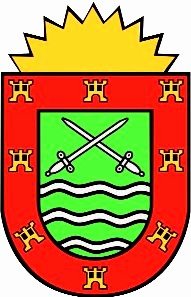http://earthobservatory.nasa.gov/NaturalHazards/natural_hazards_v2.php3?img_id=15079
Natural Hazards >> Severe Storms >>
Typhoon Hagupit
Click here to view high-resolution version (1.33MB)
Image Acquired: September 23, 2008
Typhoon Hagupit
This visualization, made with data from NASA’s QuikSCAT satellite, illustrates the power of Typhoon Hagupit as it moved towards the southern China shore on September 23, 2008. The colors depict wind speed, while the barbs point to wind direction. White barbs indicate areas of heavy rain. The image shows how symmetrical and well-formed Hagupit was. A field of strong wind, shown in purple, surrounds a perfectly circular eye of calm.
QuikSCAT measures wind by sending pulses of microwave energy through the atmosphere to the ocean and recording the energy that bounces back from the wind-roughened surface. The energy of the microwave pulses changes depending on wind speed and direction.
The wind speeds shown in this image may be lower than winds recorded on the ground. To relate the radar signal to actual wind speed, scientists compare measurements taken from buoys and other ground stations to data the satellite acquired at the same time and place. Because the high wind speeds generated by cyclones are rare, scientists do not have corresponding ground information to know how to translate data from the satellite for wind speeds above 50 knots (about 93 km/hr or 58 mph).
Also, the unusually heavy rain found in a cyclone distorts the microwave pulses in a number of ways, making a conversion to exact wind speed difficult. Instead, the scatterometer provides a nice picture of the relative wind speeds within the storm and shows wind direction. This information on winds can help forecasters pinpoint the precise location of the eye.
When QuikSCAT recorded the data used to make this image at 10:21 UTC on September 23, Hagupit was a strong Category 3 storm with winds of 195 kilometers per hour (121 miles per hour or 105 knots). It strengthened into a Category 4 storm with winds of 222 km/hr (138 mph or 120 knots) before coming ashore early on September 24. As of early September 25 (local time), the storm had caused five deaths, destroyed more than 14,000 houses, and caused an economic loss of about 824 million U.S. dollars, said Xinhua news.
References
Xinhua. (2008, September 25). Civil affairs ministry confirms five deaths in typhoon Hagupit. Published on China View. Accessed September 24, 2008.
NASA image courtesy of David Long, Brigham Young University, on the QuikSCAT Science Team, and the Jet Propulsion Laboratory. Caption by Holli Riebeek. Like this content?
Please give us your feedback, in the Earth Observatory
Feedback Survey.
-->Like this content?
Then vote for Earth Observatory in the
People's Voice (a part of the
Severe Storms:
Where in the World Image PostedSeptember 24, 2008 Satellite & SensorQuikSCAT Severe Storms Latest Events
Responsible NASA Official: Lorraine A. RemerWebmaster: Goran HalusaWe're a part of the Science Mission Directorate



No hay comentarios:
Publicar un comentario